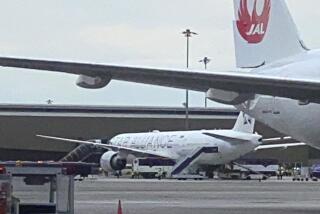Are We Destined to Die in the Air? : Human errors may be inevitable, but they need not be fatal
- Share via
There is a statistical crossroads up ahead that gives airline executives the chills. The number of aircraft in the air worldwide is growing much faster than the number of commercial aviation accidents is dropping. When these perfectly predictable numbers intersect, shortly after the turn of the century, there could be a major commercial aviation accident somewhere in the world every two or three weeks.
This was one of the scarier findings of a Times reporting team assigned to survey air safety in the wake of a runway collision that killed 34 people early this year at Los Angeles International Airport.
The airline industry knows full well that it could not survive a record like the one predicted in the year 2005, even though it would still be true that the overall accident rate was still falling. Presumably that knowledge will translate into pressure on government and on engineers to work harder on the main cause of accidents: human error.
The tendency of people to make mistakes is too often encouraged by organizational mistakes. The federal government’s traffic control system is too often understaffed and overworked. Rep. Barbara Boxer (D-Greenbrae), who chaired hearings into the LAX accident, calculated, for example, that there are 20% fewer air traffic controllers doing 50% more work than they did in 1981, the year the air traffic controllers’ union was effectively broken by President Reagan.
The articles reminded Californians that they live in what it called the “unchallenged near-miss capital of America,” with about 27% of all such incidents in the nation. The reporting team also found in searching through records that federal authorities have been warned repeatedly in the past few years about the major role of tired tower controllers in close calls, both in the air and on the ground.
Getting the Federal Aviation Administration to correct that situation must be the highest priority.
Fatigue can strike on flight decks, too. In one case a co-pilot dozed off while making a slow change in course, with the captain sound asleep in the other seat. Ground controllers saw his wanderings on radar and woke him up by radio.
The FAA is getting more aggressive about enforcing rules to minimize fatigue, but one official said there still is not enough attention being paid to commuter lines, where fatigue is a more serious factor.
Fatigue and distraction obviously figure in the fact that most serious accidents occur during takeoff or landing, the few minutes of a flight that require the most intense concentration and alertness on the part of both pilots and air traffic controllers.
Over the years, engineers have devised warning signals and other systems to help pilots and controllers overcome lapses that might get them into serious trouble. Some analysts now worry that computers and other high technology may dull the instincts that kept so many seat-of-the-pants fliers alive in the old days.
But it seems to us that the more important thing to worry about is the crossroads of 2005. The search for better technology and better organization to help people avoid and quickly recover from human mistakes must proceed full tilt.
More to Read
Inside the business of entertainment
The Wide Shot brings you news, analysis and insights on everything from streaming wars to production — and what it all means for the future.
You may occasionally receive promotional content from the Los Angeles Times.









